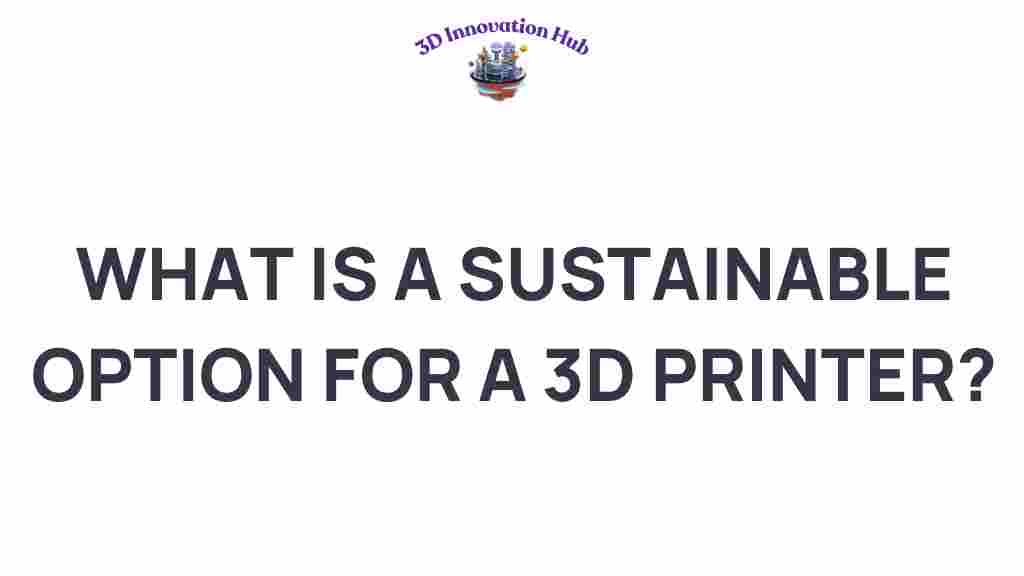Unveiling Sustainable Options for 3D Printers: A Greener Future
As the world increasingly seeks solutions to combat environmental issues, sustainable 3D printers are emerging as a beacon of hope in manufacturing. This article explores how additive manufacturing can align with eco-friendly practices, focusing on sustainable materials, green technology, and innovative approaches that reduce waste and promote a greener future.
The Importance of Sustainable 3D Printing
Sustainable 3D printing is not just a trend; it represents a significant shift in how we approach production. With traditional manufacturing processes often leading to considerable waste and emissions, moving towards a more sustainable model is essential. The use of sustainable 3D printers can:
- Reduce material waste through precise additive manufacturing techniques.
- Utilize eco-friendly materials that minimize environmental impact.
- Encourage local production, reducing transportation emissions.
What Makes a 3D Printer Sustainable?
A sustainable 3D printer incorporates various elements that contribute to its eco-friendliness. These include:
- Energy Efficiency: Using printers that consume less energy during operation.
- Material Sourcing: Employing biodegradable filaments and recycled materials.
- Waste Management: Implementing systems to recycle or repurpose leftover materials.
Exploring Eco-Friendly Materials for 3D Printing
One of the most significant components of sustainable 3D printing is the materials used. Here are some eco-friendly materials that are gaining traction:
1. Biodegradable Filaments
Biodegradable filaments are a key player in sustainable 3D printing. They break down naturally over time, reducing landfill waste. Popular types include:
- PLA (Polylactic Acid): Made from renewable resources like corn starch, PLA is one of the most widely used biodegradable filaments.
- PHA (Polyhydroxyalkanoates): This material is produced by bacteria and offers excellent biodegradability.
- Cellulose-based Filaments: Derived from wood or plant materials, these filaments provide a natural alternative to conventional plastics.
2. Recycled Filaments
Recycled filaments are produced from post-consumer plastic waste, giving new life to materials that would otherwise end up in landfills. Using recycled filaments reduces the demand for new plastic production and decreases environmental impact.
3. Sustainable Composites
These materials combine traditional plastics with organic materials, such as hemp or flax. They provide enhanced mechanical properties while remaining more environmentally friendly than standard plastics.
Green Technology in 3D Printing Innovations
The integration of green technology in 3D printing is revolutionizing the industry. Here are some innovations to look out for:
1. Energy-Efficient Printers
Modern 3D printers are designed with energy efficiency in mind. Features such as auto-sleep modes and efficient heating elements help reduce energy consumption during printing.
2. Advanced Recycling Techniques
Innovations in recycling technology allow for the recovery and reuse of materials in 3D printing. Closed-loop systems can process waste materials back into usable filament, promoting a circular economy.
3. Localized Production
3D printing enables localized production, which diminishes the need for long-distance transportation of goods. This not only reduces carbon footprints but also supports local economies.
Step-by-Step Process for Sustainable 3D Printing
To fully embrace sustainable 3D printing, follow this step-by-step process:
Step 1: Choose a Sustainable 3D Printer
Select a 3D printer that is designed for energy efficiency and compatible with eco-friendly materials. Look for models that have received sustainability certifications.
Step 2: Select Eco-Friendly Materials
Opt for biodegradable filaments or recycled materials. Ensure that the materials you choose are suitable for your specific printing needs.
Step 3: Optimize Your Print Settings
Adjust your printer settings to minimize energy usage and material waste. This includes calibrating temperature settings, layer height, and print speed.
Step 4: Implement Waste Reduction Practices
Utilize leftover materials and scraps for smaller projects or experiments. Consider investing in a filament recycler to turn waste back into usable filament.
Step 5: Educate and Share
Share your sustainable practices with others in the 3D printing community. Education is key to promoting eco-friendly innovations and encouraging collective action.
Troubleshooting Tips for Sustainable 3D Printing
Even with sustainable practices, challenges may arise. Here are some troubleshooting tips:
1. Poor Print Quality
- Check the calibration of your printer.
- Ensure you are using the correct nozzle size for the filament type.
- Adjust print speed and temperature settings to match the filament specifications.
2. Filament Jamming
- Clean the nozzle regularly to prevent clogs.
- Store filaments in a dry and cool place to avoid moisture absorption, which can cause jamming.
3. Inconsistent Material Flow
- Check for any obstructions in the filament path.
- Ensure the filament is not tangled or damaged.
Conclusion: Building a Greener Future with Sustainable 3D Printers
As we continue to face environmental challenges, the adoption of sustainable 3D printer technology is crucial. By choosing eco-friendly materials, embracing green technology, and optimizing our printing processes, we can significantly reduce our ecological footprint. Innovations in additive manufacturing not only promote sustainability but also pave the way for a more responsible and efficient future in manufacturing.
For further reading on sustainable practices in manufacturing, check out this resource. To learn more about the latest innovations in 3D printing, visit our blog.
This article is in the category and created by 3D Innovation Hub Team
